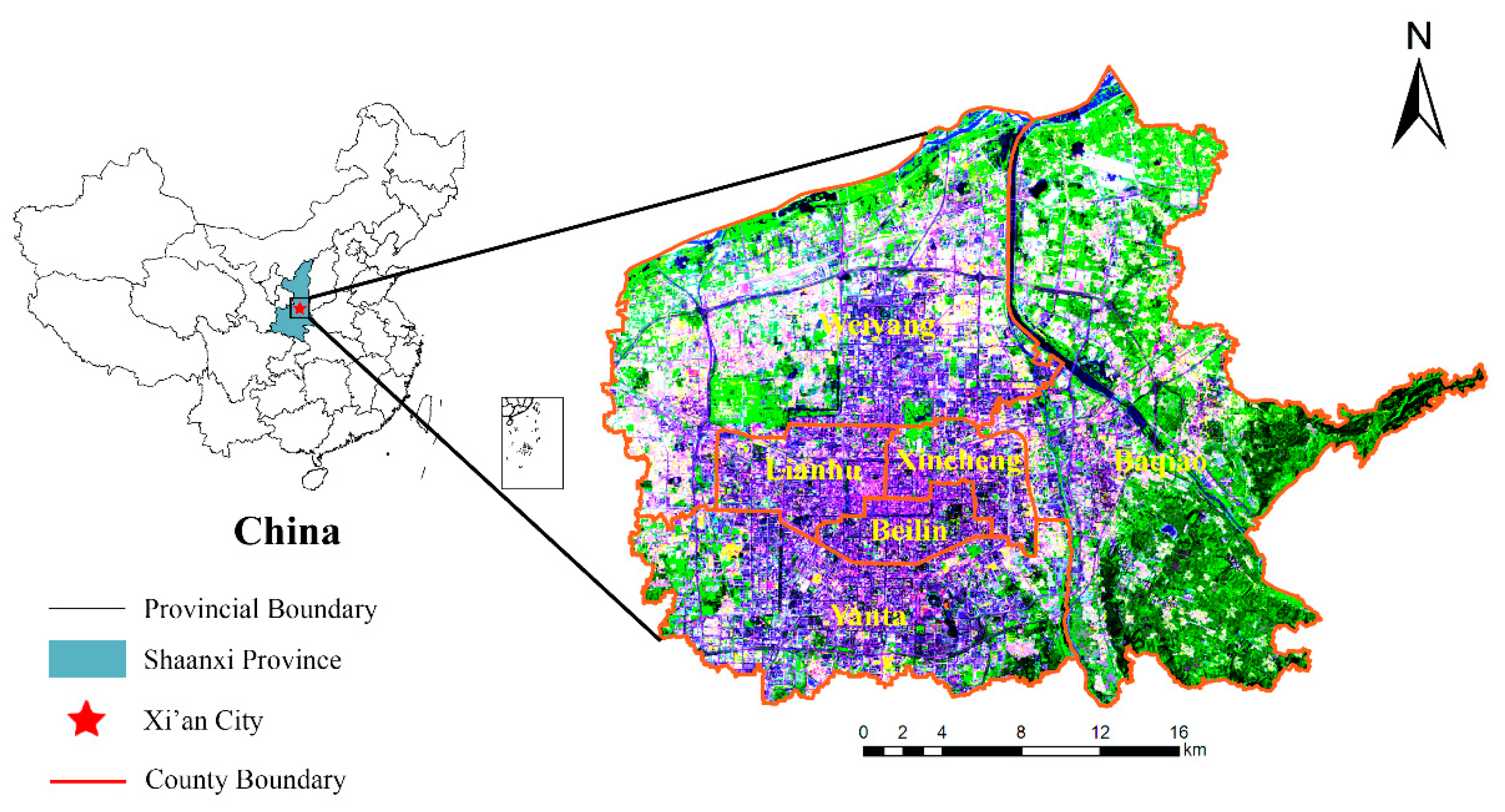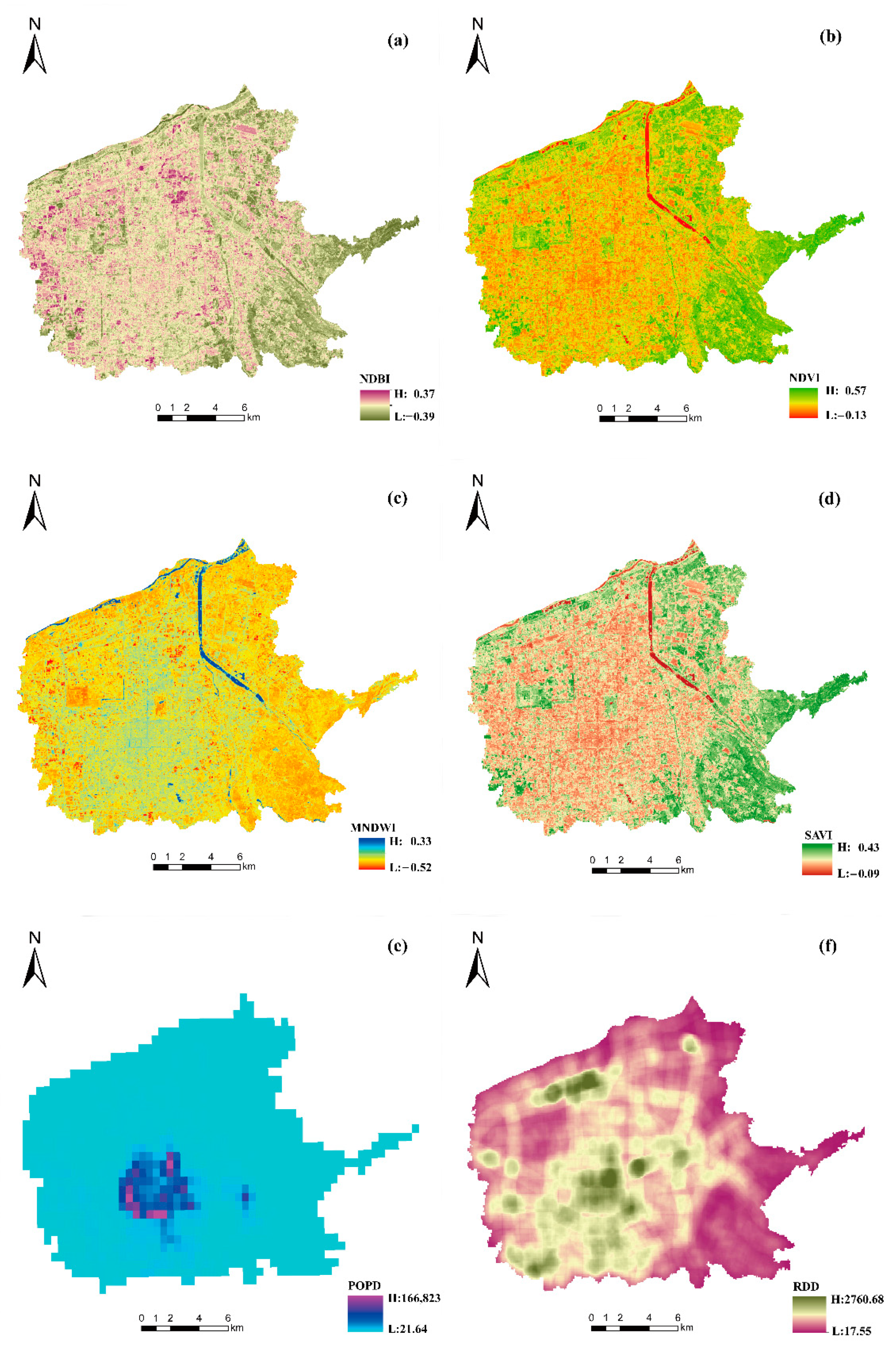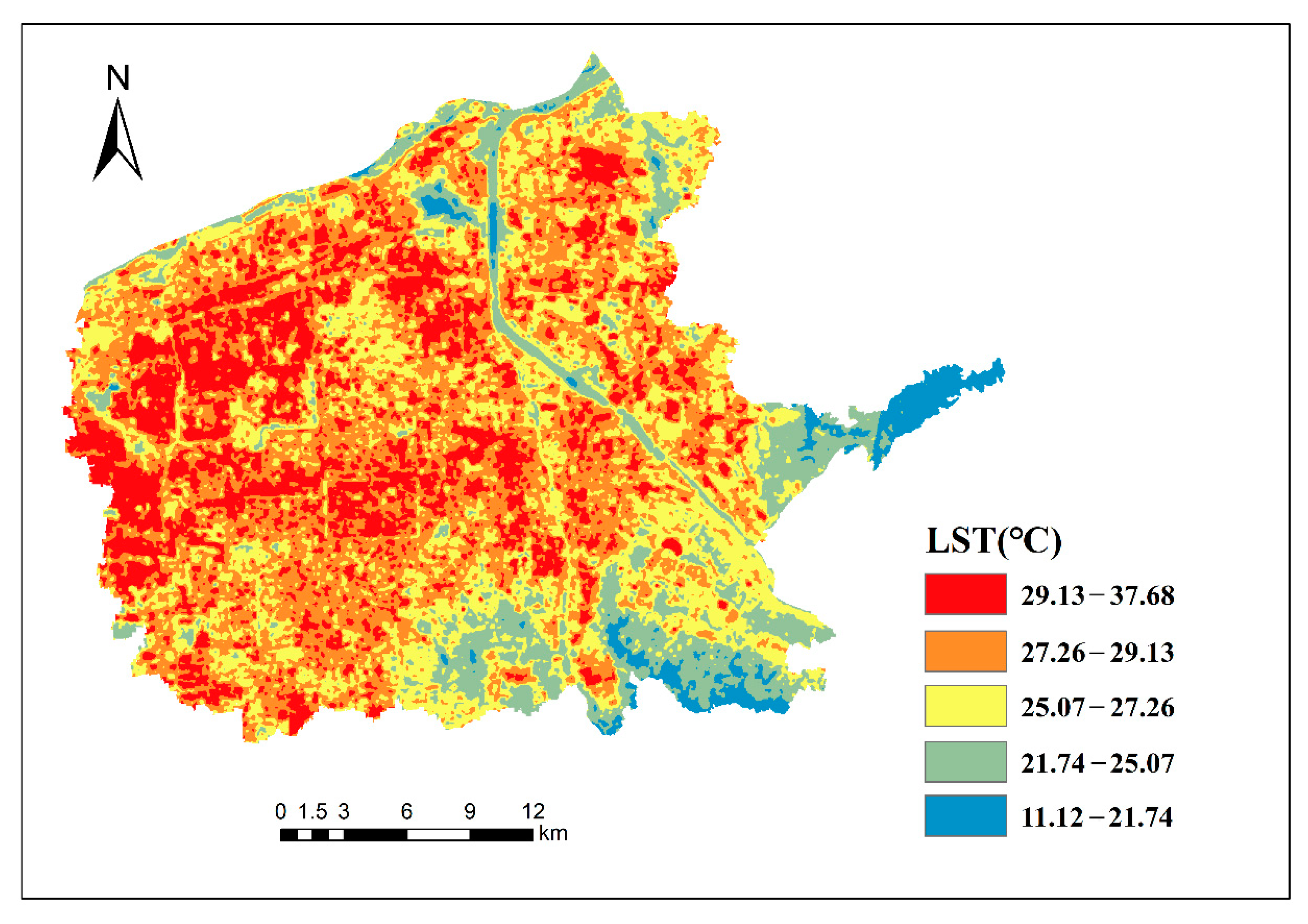Quantitative Analysis of Spatial Heterogeneity and Driving Forces of the Thermal Environment in Urban Built-up Areas: A Case Study in Xi’an, China
Abstract
1. Introduction
2. Materials and Methods
2.1. Overview of the Study Area
2.2. Data Sources
2.3. Methodology
2.3.1. Surface Temperature Computation
2.3.2. Spatial Autocorrelation Analysis
2.3.3. Hot Spot Analysis
2.3.4. Selection of Driving Factors for LST Change
2.3.5. Statistical Analysis
2.3.6. Driving Factor Analysis
- Non-linear reduction: Q(X1 ∩ X2) < Min(q(X1), q(X2)).
- Single-factor non-linear attenuation: Min(q(x1), q(x2))<q(x1 ∩ x2)<Max(q(x1), q(x2)).
- Two-factor enhancement: Q(X1 ∩ X2) > Max(q(X1), q(X2)).
- Independent: Q(X1∩X2) < q(X1) + q(X2).
- Non-linear enhancement: Q(X1 ∩ X2) > q(X1) + q(X2).
3. Results
3.1. Impact of a Single Driver on LST
3.2. LST Spatial Autocorrelation Analysis
3.3. Interaction of Driver Factors on LST
4. Discussion
5. Conclusions
Author Contributions
Funding
Institutional Review Board Statement
Informed Consent Statement
Data Availability Statement
Acknowledgments
Conflicts of Interest
References
- Wang, H.; He, Q.; Liu, X.; Zhuang, Y.; Hong, S. Global urbanization research from 1991 to 2009: A systematic research review. Landsc. Urban Plan. 2012, 104, 299–309. [Google Scholar] [CrossRef]
- United Nations. World Urbanization Prospects: The 2018 Revision; United Nations Publications: New York, NY, USA, 2019. [Google Scholar]
- Chakraborty, T.; Lee, X. A simplified urban-extent algorithm to characterize surface urban heat islands on a global scale and examine vegetation control on their spatiotemporal variability. Int. J. Appl. Earth Obs. Geoinf. 2019, 74, 269–280. [Google Scholar] [CrossRef]
- Zhou, D.; Xiao, J.; Bonafoni, S.; Berger, C.; Deilami, K.; Zhou, Y.; Frolking, S.; Yao, R.; Qiao, Z.; Sobrino, J. Satellite Remote Sensing of Surface Urban Heat Islands: Progress, Challenges, and Perspectives. Remote Sens. 2019, 11, 48. [Google Scholar] [CrossRef]
- Bhati, S.; Mohan, M. WRF model evaluation for the urban heat island assessment under varying land use/land cover and reference site conditions. Theor. Appl. Climatol. 2016, 126, 385–400. [Google Scholar] [CrossRef]
- Tan, J.; Zheng, Y.; Tang, X.; Guo, C.; Li, L.; Song, G.; Zhen, X.; Yuan, D.; Kalkstein, A.J.; Li, F.; et al. The urban heat island and its impact on heat waves and human health in Shanghai. Int. J. Biometeorol. 2010, 54, 75–84. [Google Scholar] [CrossRef] [PubMed]
- Heaviside, C.; Macintyre, H.; Vardoulakis, S. The urban heat island: Implications for health in a changing environment. Curr. Environ. Health Rep. 2017, 4, 296–305. [Google Scholar] [CrossRef]
- Wong, L.P.; Alias, H.; Aghamohammadi, N.; Aghazadeh, S.; Sulaiman, N.M.N. Urban heat island experience, control measures and health impact: A survey among working community in the city of Kuala Lumpur. Sustain. Cities Soc. 2017, 35, 660–668. [Google Scholar] [CrossRef]
- Kuang, W.; Liu, A.; Dou, Y.; Li, G.; Lu, D. Examining the impacts of urbanization on surface radiation using Landsat imagery. Gisci. Remote Sens. 2018, 56, 462–484. [Google Scholar] [CrossRef]
- Peng, J.; Jia, J.; Liu, Y.; Li, H.; Wu, J. Seasonal contrast of the dominant factors for spatial distribution of land surface temperature in urban areas. Remote Sens. Environ. 2018, 215, 255–267. [Google Scholar] [CrossRef]
- Guo, L.; Liu, R.; Men, C.; Wang, Q.; Miao, Y.; Zhang, Y. Quantifying and simulating landscape composition and pattern impacts on land surface temperature: A decadal study of the rapidly urbanizing city of Beijing, China. Sci. Total Environ. 2019, 654, 430–440. [Google Scholar] [CrossRef]
- Madanian, M.; Soffianian, A.R.; Koupai, S.S.; Pourmanafi, S.; Momeni, M. Analyzing the effects of urban expansion on land surface temperature patterns by landscape metrics: A case study of Isfahan city, Iran. Environ. Monit. Assess. 2018, 190, 1–11. [Google Scholar] [CrossRef] [PubMed]
- Firoozy, N.M.; Zoratipour, A. Assessment of LST and NDMI indices using MODIS and Landsat images in Karun riparian forest. J. For. Sci. 2019, 65, 27–32. [Google Scholar] [CrossRef]
- He, B.J.; Zhao, Z.Q.; Shen, L.D.; Wang, H.B.; Li, L.G. An approach to examining performances of cool/hot sources in mitigating/enhancing land surface temperature under different temperature backgrounds based on landsat 8 image. Sustain. Cities Soc. 2019, 44, 416–427. [Google Scholar] [CrossRef]
- Sherafati, S.; Saradjian, M.R.; Rabbani, A. Assessment of Surface Urban Heat Island in Three Cities Surrounded by Different Types of Land-Cover Using Satellite Images. J. Indian Soc. Remote Sens. 2018, 46, 1013–1022. [Google Scholar] [CrossRef]
- Alvarez-Mendoza, C.I.; Teodoro, A.; Freitas, A.; Fonseca, J. Spatial estimation of chronic respiratory diseases based on machine learning procedures—An approach using remote sensing data and environmental variables in quito, Ecuador. Appl. Geogr. 2020, 123, 102273. [Google Scholar] [CrossRef]
- Keeratikasikorn, C.; Bonafoni, S. Urban Heat Island Analysis over the Land Use Zoning Plan of Bangkok by Means of Landsat 8 Imagery. Remote Sens. 2018, 10, 440. [Google Scholar] [CrossRef]
- Weng, Q.; Firozjaei, M.K.; Sedighi, A.; Kiavarz, M.; Alavipanah, S.K. Statistical analysis of surface urban heat island intensity variations: A case study of Babol city, Iran. Gisci. Remote Sens. 2018, 56, 576–604. [Google Scholar] [CrossRef]
- Sun, R.; Lü, Y.; Yang, X.; Chen, L. Understanding the variability of urban heat islands from local background climate and urbanization. J. Clean. Prod. 2019, 208, 743–752. [Google Scholar] [CrossRef]
- Cai, Y.; Chen, Y.; Tong, C. Spatiotemporal evolution of urban green space and its impact on the urban thermal environment based on remote sensing data: A case study of Fuzhou City, China. Urban For. Urban Green. 2019, 41, 333–343. [Google Scholar] [CrossRef]
- Amani-Beni, M.; Zhang, B.; Xu, J. Impact of urban park’s tree, grass and waterbody on microclimate in hot summer days: A case study of Olympic Park in Beijing, China. Urban For. Urban Green. 2018, 32, 1–6. [Google Scholar] [CrossRef]
- Wang, J.F.; Xu, C.D. Geodetector: Principle and prospective. Acta Geogr. Sin. 2017, 72, 116–134. [Google Scholar]
- Shrestha, A.; Luo, W. Analysis of groundwater nitrate contamination in the Central Valley: Comparison of the geodetector method, principal component analysis and geographically weighted regression. Int. J. Geo-Inf. 2017, 6, 297. [Google Scholar] [CrossRef]
- Xu, C.; Li, Y.; Wang, J.; Xiao, G. Spatial-temporal detection of risk factors for bacillary dysentery in Beijing, Tianjin and Hebei, China. BMC Public Health 2017, 17, 1–11. [Google Scholar] [CrossRef]
- Wang, J.F.; Li, X.H.; Christakos, G.; Liao, Y.H.; Zhang, T.; Gu, X.; Zheng, X.Y. Geographical detectors-based health risk assessment and its application in the neural tube defects study of the Heshun Region, China. Int. J. Geogr. Inf. Sci. 2010, 24, 107–127. [Google Scholar] [CrossRef]
- Liang, X.Y.; Li, Y.B. Spatio-temporal features of scaling farmland and its corresponding driving mechanism in Three Gorges ReservoirArea. Acta Geogr. Sin. 2018, 73, 1630–1646. [Google Scholar]
- Ye, S.J.; Song, C.Q.; Shen, S.; Gao, P.C.; Cheng, C.X.; Cheng, F.; Wan, C.J.; Zhu, D.H. Spatial pattern of arable land-use intensity in China. Land Use Policy 2020, 99, 1–13. [Google Scholar] [CrossRef]
- Zhu, L.J.; Meng, J.J.; Zhu, L.K. Applying Geodetector to disentangle the contributions of natural and anthropogenic factors to NDVI variations in the middle reaches of the Heihe River Basin. Ecol. Indic. 2020, 117, 1–13. [Google Scholar] [CrossRef]
- Zhao, Y.L.; Ren, H.Y.; Li, X.B. Forest transition and its driving forces in the Qian-Gui Karst mountainous areas. J. Resour. Ecol. 2020, 11, 59–68. [Google Scholar]
- Chen, J. Spatial dynamic modeling of tropical forest change. Ph.D. Thesis, University of Alberta, Edmonton, AB, Canada, 2020. [Google Scholar]
- Zhao, R.; Zhan, L.P.; Yao, M.X.; Yang, L.C. A geographically weighted regression model augmented by geodetector analysis and principal component analysis for the spatial distribution of PM2.5. Sustain. Cities Soc. 2020, 56, 102106. [Google Scholar] [CrossRef]
- Yang, Y.; Yang, X.; He, M.J.; Christakos, G. Beyond mere pollution source identification: Determination of land covers emitting soil heavy metals by combining PCA/APCS, GeoDetector and GIS analysis. Catena 2020, 185, 104297. [Google Scholar] [CrossRef]
- Yang, Q.Q.; Yuan, Q.Q.; Yue, L.W.; Li, T.W. Investigation of the spatially varying relationships of PM2.5 with meteorology, topography, and emissions in China in 2015 by using modified geographically weighted regression. Environ. Pollut. 2020, 262, 1–10. [Google Scholar] [CrossRef]
- Lai, H.H. China’s western development program: Its rationale, implementation, and prospects. Mod. China 2002, 28, 432–466. [Google Scholar] [CrossRef]
- Economic Performance of Xi’an in 2020. Available online: http://tjj.xa.gov.cn/tjsj/tjxx/600a40e2f8fd1c2073ec66bf.html (accessed on 22 January 2021).
- Cooley, T.; Anderson, G.P.; Felde, G.W.; Hoke, M.L.; Ratkowski, A.J.; Chetwynd, J.H.; Gardner, J.A.; Adler-Golden, S.M.; Matthew, M.W.; Berk, A.; et al. FLAASH, a MODTRAN4-based atmospheric correction algorithm, its application and validation. Ieee Int. Geosci. Remote Sens. Symp. 2002, 3, 1414–1418. [Google Scholar]
- Weng, Q.; Lu, D.; Schubring, J. Estimation of land surface temperature-vegetation abundance relationship for urban heat island studies. Remote Sens. Environ. 2004, 89, 467–483. [Google Scholar] [CrossRef]
- Artis, D.A.; Carnahan, W.H. Survey of emissivity variability in thermography of urban areas. Remote Sens. Environ. 1982, 12, 313–329. [Google Scholar] [CrossRef]
- Sobrino, J.A.; Munoz, J.C.; Paolini, L. Land surface temperature retrieval from Landsat TM5. Remote Sens. Environ. 2004, 9, 434–440. [Google Scholar] [CrossRef]
- Sobrino, J.A.; Raissouni, N.; Li, Z.L. A comparative study of land surface emissivity retrieval from NOAA data. Remote Sens. Environ. 2001, 75, 256–266. [Google Scholar] [CrossRef]
- Carlson, T.N.; Ripley, D.A. On the relation between NDVI, fractional vegetation cover, and leaf area index. Remote Sens. Environ. 1997, 62, 241–252. [Google Scholar] [CrossRef]
- GU, J.L.; Zhang, H.T.; Chen, J.Y. Analysis of land use spatial autocorrelation patterns based on DEM data. Trans. Chin. Soc. Agric. Eng. 2013, 28, 216–224. (In Chinese) [Google Scholar]
- Wu, Z.; Zhang, Y. Spatial variation of urban thermal environment and its relation to green space patterns: Implication to sustainable landscape planning. Sustainability 2018, 10, 2249. [Google Scholar] [CrossRef]
- Li, X.; Zhou, W. Spatial patterns and driving factors of surface urban heat island intensity: A comparative study for two agriculture-dominated regions in China and the USA. Sustain. Cities Soc. 2019, 48, 101518. [Google Scholar] [CrossRef]
- Sun, Y.; Gao, C.; Li, J.; Li, W.; Ma, R. Examining urban thermal environment dynamics and relations to biophysical composition and confifiguration and socioeconomic factors: A case study of the Shanghai metropolitan region. Sustain. Cities Soc. 2018, 40, 284–295. [Google Scholar] [CrossRef]
- Tucker, C.J.; Vanpraet, C.L.; Sharman, M.J.; Ittersum, G.V. Satellite remote sensing of total herbaceous biomass production in the senegalese sahel: 1980–1984. Remote Sens. Environ. 1985, 17, 233–249. [Google Scholar] [CrossRef]
- Huete, A.R. A soil-adjusted vegetation index (savi). Remote Sens. Environ. 1988, 25, 295–309. [Google Scholar] [CrossRef]
- Zha, Y.; Gao, J.; Ni, S. Use of normalized difference built-up index in automatically mapping urban areas from TM imagery. Int. J. Remote Sens. 2010, 24, 583–594. [Google Scholar] [CrossRef]
- Xu, H.Q. Modifification of normalized difference water index (MNDWI) to enhance open water features in remotely sensed imagery. Int. J. Remote Sens. 2006, 27, 3025–3033. [Google Scholar] [CrossRef]
- Yu, B.; Tang, M.; Wu, Q.; Yang, C.; Deng, S.; Shi, K.; Peng, C.; Wu, J.; Chen, Z. Urban Built-Up Area Extraction From Log- Transformed NPP-VIIRS Nighttime Light Composite Data. Ieee Geosci. Remote Sens. Lett. 2018, 15, 1279–1283. [Google Scholar] [CrossRef]
- WorldPop. Available online: www.worldpop.org (accessed on 7 February 2021).
- Hu, D.; Meng, Q.Y.; Zhang, L.L.; Zhang, Y. Spatial quantitative analysis of the potential driving factors of land surface temperature in different ‘‘Centers” of polycentric cities: A case study in Tianjin, China. Sci. Total Environ. 2020, 706, 1–15. [Google Scholar] [CrossRef] [PubMed]
- Wang, J.F.; Hu, Y. Environmental health risk detection with GeogDetector. Environ. Model. Softw. 2012, 33, 114–115. [Google Scholar] [CrossRef]
- Zhang, W.; Jiang, J.; Zhu, Y. Spatial-temporal evolution of urban thermal environment based on spatial statistical features. Chin. J. Appl. Ecol. 2015, 26, 1840–1846. (In Chinese) [Google Scholar]
- Chen, G.D.; Xu, J.H.; Dai, X.Y.; Dong, S. Applying Geo-data Mining to Analysis Spatial Variance Characters of Urban Land Surface Temperature. Remote Sens. Technol. Appl. 2008, 23, 405–409. (In Chinese) [Google Scholar]
- Wang, J.; Hu, M.; Zhang, F.; Gao, B. Influential factors detection for surface water quality with geographical detectors in China. Stoch. Environ. Res. Risk Assess. 2018, 32, 2633–2645. [Google Scholar] [CrossRef]
- Cao, L.; Li, P.; Zhang, L. Impact of impervious surface on urban heat island in Wuhan, China. Int. Soc. Opt. Photonics 2008, 7285, 72855H. [Google Scholar]
- Li, Y.; Zhang, H.; Kainz, W. Monitoring patterns of urban heat islands of the fast-growing Shanghai metropolis, China: Using time-series of Landsat TM/ETM+ data. Int. J. Appl. Earth Obs. Geoinf. 2012, 19, 127–138. [Google Scholar] [CrossRef]




| Driving Factors | Acronym/Abbreviation | Formulas | Documentary Sources |
|---|---|---|---|
| Normalized difference vegetation Index | NDVI | [46] | |
| Soil-regulating vegetation index | SAVI | [47] | |
| Normalized building index | NDBI | [48] | |
| Modified Normalized Difference Water Index | MNDWI | [49] | |
| Road density | RDD | [50] | |
| Population density | POPD | [51] |
| Driving Factors (Xi) | Level of Impact (q-Value) | Significance Level (p-Value) | q-Value Ordering |
|---|---|---|---|
| NDBI | 0.7593 | 0.000 | 1 |
| NDVI | 0.6356 | 0.000 | 2 |
| MNDWI | 0.1239 | 1 | 4 |
| SAVI | 0.6356 | 0.000 | 2 |
| RDD | 0.4619 | 0.000 | 3 |
| POPD | 0.0352 | 1 | 5 |
| Interaction factor(X1 ∩ X2) | P(X1) | P(X2) | P(X1 ∩ X2) | Interaction Results | Impact Model |
|---|---|---|---|---|---|
| NDBI ∩ NDVI | 0.7593 | 0.6356 | 0.7754 | P(X1 ∩ X2) > max(P(X1),P(X2)) | Double factor enhancement |
| NDBI ∩ MNDWI | 0.7593 | 0.1239 | 0.8108 | P(X1 ∩ X2) > max(P(X1),P(X2)) | Double factor enhancement |
| NDBI ∩ SAVI | 0.7593 | 0.6356 | 0.7754 | P(X1 ∩ X2) > max(P(X1),P(X2)) | Double factor enhancement |
| NDBI ∩ RDD | 0.7593 | 0.4619 | 0.8002 | P(X1 ∩ X2) > max(P(X1),P(X2)) | Double factor enhancement |
| NDBI ∩ POPD | 0.7593 | 0.0352 | 0.7710 | P(X1 ∩ X2) > max(P(X1),P(X2)) | Double factor enhancement |
| NDVI ∩ MNDWI | 0.6356 | 0.1239 | 0.7926 | P(X1 ∩ X2) > P(X1) + P(X2) | Non-linear enhancement |
| NDVI ∩ SAVI | 0.6356 | 0.6356 | 0.6370 | P(X1 ∩ X2) > max(P(X1),P(X2)) | Double factor enhancement |
| NDVI ∩ RDD | 0.6356 | 0.4619 | 0.7050 | P(X1 ∩ X2) > max(P(X1),P(X2)) | Double factor enhancement |
| NDVI ∩ POPD | 0.6356 | 0.0352 | 0.6444 | P(X1 ∩ X2) > max(P(X1),P(X2)) | Double factor enhancement |
| MNDWI ∩ SAVI | 0.1239 | 0.6356 | 0.7926 | P(X1 ∩ X2) > P(X1)+P(X2) | Non-linear enhancement |
| MNDWI ∩ RDD | 0.1239 | 0.4619 | 0.5191 | P(X1 ∩ X2) > max(P(X1),P(X2)) | Double factor enhancement |
| MNDWI ∩ POPD | 0.1239 | 0.0352 | 0.1459 | P(X1 ∩ X2) > max(P(X1),P(X2)) | Double factor enhancement |
| SAVI ∩ RDD | 0.6356 | 0.4619 | 0.7050 | P(X1 ∩ X2) > max(P(X1),P(X2)) | Double factor enhancement |
| SAVI ∩ POPD | 0.6356 | 0.0352 | 0.6444 | P(X1 ∩ X2) > max(P(X1),P(X2)) | Double factor enhancement |
| RDD ∩ POPD | 0.4619 | 0.0352 | 0.4738 | P(X1 ∩ X2) > max(P(X1),P(X2)) | Double factor enhancement |
Publisher’s Note: MDPI stays neutral with regard to jurisdictional claims in published maps and institutional affiliations. |
© 2021 by the authors. Licensee MDPI, Basel, Switzerland. This article is an open access article distributed under the terms and conditions of the Creative Commons Attribution (CC BY) license (http://creativecommons.org/licenses/by/4.0/).
Share and Cite
Zhao, X.; Liu, J.; Bu, Y. Quantitative Analysis of Spatial Heterogeneity and Driving Forces of the Thermal Environment in Urban Built-up Areas: A Case Study in Xi’an, China. Sustainability 2021, 13, 1870. https://doi.org/10.3390/su13041870
Zhao X, Liu J, Bu Y. Quantitative Analysis of Spatial Heterogeneity and Driving Forces of the Thermal Environment in Urban Built-up Areas: A Case Study in Xi’an, China. Sustainability. 2021; 13(4):1870. https://doi.org/10.3390/su13041870
Chicago/Turabian StyleZhao, Xuan, Jianjun Liu, and Yuankun Bu. 2021. "Quantitative Analysis of Spatial Heterogeneity and Driving Forces of the Thermal Environment in Urban Built-up Areas: A Case Study in Xi’an, China" Sustainability 13, no. 4: 1870. https://doi.org/10.3390/su13041870
APA StyleZhao, X., Liu, J., & Bu, Y. (2021). Quantitative Analysis of Spatial Heterogeneity and Driving Forces of the Thermal Environment in Urban Built-up Areas: A Case Study in Xi’an, China. Sustainability, 13(4), 1870. https://doi.org/10.3390/su13041870





